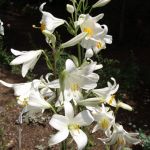| Common Name: |
Madonna Lily |
| Botanical Name: |
Lilium candidum |
| Genus: |
Lilium |
| Family: |
Liliaceae |
| Native Location: |
SE Europe, E Mediterranean |
| Cultivation: |
Well-drained alkaline soil in sun, with the bulb just below the surface. Prone to Botrytis infection and viruses; resents disturbance. |
| Propagation: |
By seed sown when ripe; by scales and offsets when dormant in spring. |
| Harvest: |
Bulbs are lifted in late summer, and flowers picked as they open; they are used fresh for juice, ointments, tinctures, or may be frozen for later use. |
| Height: |
1-1.8m (3-6ft) |
| Hardiness: |
Z4-9 |
| Parts Used: |
Bulbs, flowers |
| Properties: |
An astringent, mucilaginous herb that heals damaged or irritated tissues. |
| Medicinal Uses: |
Externally for burns, abscesses, chapped or inflamed skin, chilblains, ulcers, and hair loss. |
| Bibliography: |
Encylopedia of Herbs by Deni Brown Copyright ©: 1995, 2001 Dorling Kindersley Limited pg 262
|

